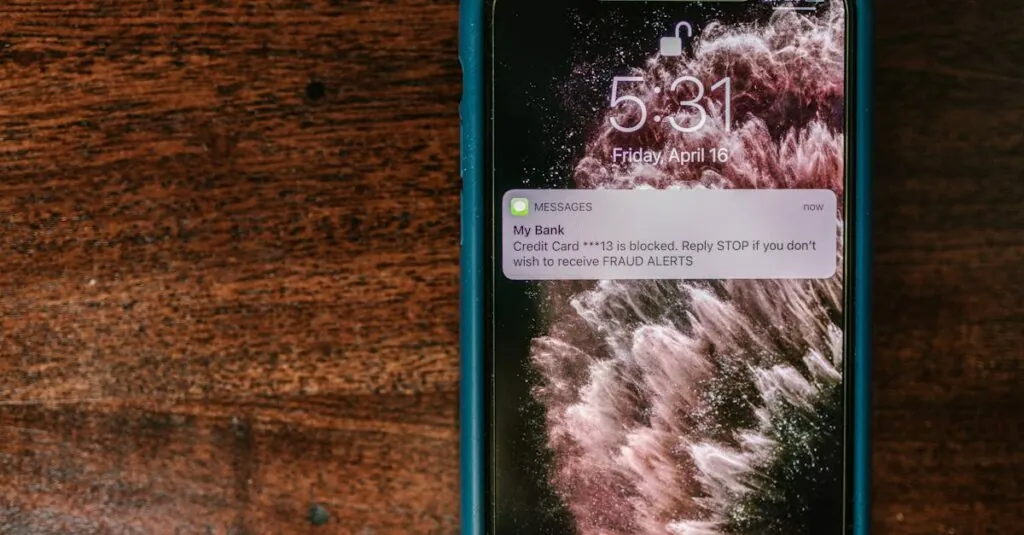Table of Contents
ToggleEver had that sinking feeling when your texts go unanswered? You send a message, and it’s like your words vanished into a black hole. If you’re an iPhone user, you might be wondering: am I blocked? It’s a modern-day mystery that leaves many scratching their heads and questioning their social status.
Understanding Blocking on iPhone
Blocking on an iPhone occurs when a user prevents another from contacting them. This action restricts calls, texts, and FaceTime communications, resulting in a significant shift in interaction dynamics.
What Does Being Blocked Mean?
Being blocked means a user can no longer reach another person through iPhone communication features. Messages sent won’t show as delivered, and calls typically go straight to voicemail. The blocked individual sees no notifications about the block, creating confusion. Understanding these aspects clarifies potential miscommunications. Users sometimes feel unsure if they’ve been blocked or if the other person is simply unavailable.
Common Reasons for Being Blocked
Several reasons lead to blocking someone on an iPhone. Personal conflicts often trigger this action, such as arguments or misunderstandings. Some users may feel overwhelmed by unwanted messages or calls, prompting them to block certain contacts. Prioritizing mental health or establishing boundaries also plays a role in this decision. Users might block others to avoid harassment or unwanted advances, ensuring a safer communication environment.
Signs That You May Be Blocked
Noticing signs of being blocked on an iPhone can be unsettling. Different behaviors in calls, messages, and FaceTime interactions may indicate the likelihood of being blocked.
Call Behavior
Calls to a blocked number typically redirect to voicemail without ringing. Observing this pattern repeatedly can raise suspicions. If calls consistently go straight to voicemail without any indication of being answered, it suggests a potential block. Additionally, if the recipient doesn’t return calls after multiple attempts, it’s another sign worth considering.
Message Notifications
When sending texts, a lack of the “Delivered” status often signals being blocked. Typically, iPhone users see this notification under messages, confirming receipt. If messages only show as sent, the absence of “Delivered” is a significant clue. Moreover, if the sender consistently does not receive replies after reaching out several times, it’s reasonable to suspect a block.
FaceTime Indicators
FaceTime calls may also reveal signs of being blocked. If attempts to connect fail consistently and show “failed” status immediately, there’s a possibility of a block. Not hearing the recipient’s phone ring during multiple calls further highlights this. If the individual cannot see the recipient’s status online or if they appear as unavailable frequently, these factors may also indicate a block.
Confirming If You Are Blocked
Determining if someone has blocked you on iPhone involves various methods. These methods help clarify the situation without causing unnecessary confrontations.
Using Alternative Communication Methods
Try reaching out via different messaging apps. If texts go unanswered, platforms like WhatsApp or Facebook Messenger can be useful. When a user blocks someone, these alternate communications may yield different results. If messages go through or receive replies in other apps, it suggests the iPhone block may not exist. However, limited responses still might indicate boundaries. Ensure direct communication remains respectful to avoid further misunderstandings.
Checking Social Media Activity
Investigate interactions on social media platforms. If a blocked person typically sees posts or status updates, their absence can signal a block. Liking or commenting patterns often change once someone blocks another user. When checking mutual friends, behavior may also shift, hinting at the individual’s current communication preference. Moreover, observing whether they appear active or engage with other contacts assists in confirming any concerns. Be mindful that privacy settings can affect visibility, so interpretations must remain cautious.
Steps to Take If You Suspect Being Blocked
Facing the possibility of being blocked on an iPhone can lead to uncertainty. Taking deliberate steps often helps clarify the situation.
Assessing Your Relationship
Reflecting on the nature of the relationship proves essential. Take note of recent interactions to gauge any changes in behavior. Conflicts may warrant reevaluation of how messages were communicated. Individuals often block others due to personal boundaries, so consider past conversations. Acknowledging any disagreements helps understand potential reasons behind the perceived block. Reviewing past texts may reveal tone or context that unintentionally upset the other person. This assessment encourages open-mindedness while seeking clarity.
Communicating Your Concerns
Addressing feelings directly with the other person can foster understanding. Start by expressing confusion about the lack of responses. Using a calm, non-confrontational approach encourages dialogue. Open-ended questions facilitate honest explanations; for example, “I noticed you haven’t been responding lately—anything on your mind?” Consider utilizing alternative messaging platforms if direct communication feels challenging. Privacy settings may be impacting visibility, so don’t make assumptions based solely on silence. Prioritizing sincerity in conversations allows for a clearer understanding and may help resolve misunderstandings.
Navigating the complexities of digital communication can be challenging. When someone suspects they’ve been blocked on their iPhone it can lead to feelings of confusion and anxiety. Understanding the signs and potential reasons for being blocked can help individuals address their concerns more effectively.
By exploring alternative communication methods or assessing changes in social interactions, they can gain clarity without escalating tensions. Ultimately open and honest dialogue remains key to resolving misunderstandings and fostering healthier relationships.




